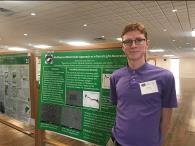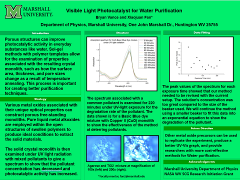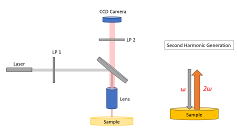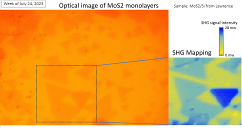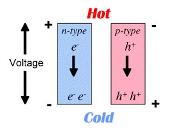|
Marshall Digital Readership Record
News: new publication accepted, Xiaojuan Fan, “Advanced progress in metal halide perovskite solar cells: A review”, Materials Today Sustainability, 24 (2023) 100603, shared link: https://www.sciencedirect.com/science/article/pii/S2589234723002907?dgcid=author free access before Jan.9, 2024.
Undergraduate Research
Project 1: Multilayered Metal Oxide Approach to Infrared Light Absorption
Project 2: Visible Light Photocatalyst for Water Purification
Ongoing recruitment for undergraduate research students. Please contact Dr. Fan if you are interested in her research.
Recent scholarly achievements: · Non-linear optics—second harmonic generation (SHG) has been successfully mapped on MoS2 monolayers through infrared laser reflectance by an optical Spectro microscopy system. Ultra strong SHG signals were also collected from thicker single crystalline thin films, possible application on producing double-frequency light.
· Grantee of the 2022-2023 NASA WV Space Grant Consortium Research Initiation Grant. Project title: Multiple-layered coatings for thermal protection from elevated temperatures in space, $30,000. · Awardee of the 2022 Air Force Research Lab Summer Faculty Fellowship at AFRL-Materials and Manufacturing. Project title: Sandwich Devices for Thermal Protection and Infrared Invisibility. · 2022 John Marshall Summer Scholarship Award. Project title: Thermal-Photo-Electronic Hybrid Device for Energy Harvesting. · Peer-reviewed Journal publication, Xiaojuan Fan, “Flexible dye-sensitized solar cells assisted with lead-free perovskite halide”, Journal of Materials Research, invited paper, vol. 37, issue 4 (2022) 866-875. · Guest Editor: Nanomanufacturing, special issue on “Nanomanufacturing of photoactive materials: from synthesis to applications”. Now call for paper with submission due on Jan. 1, 2023. Publisher: MDPI, Switzerland. Website: https://www.mdpi.com/journal/nanomanufacturing. Click here to find more information · NASA Research Initiation Awards proposal: “MemDiodes Based on Bio-Compatible Hybrid Materials for Neuromorphic Computing”, $299,999, 2024-2026, submitted and pending. · NSF Engineering Research Initiation: Thermophotovoltaic Hybrid Devices for Energy Harvesting, $200,000, 2024-2026, submitted and pending. · NASA Bridge Seed Funding: “NASA BPSF proposal: Metal-Oxide Reinforced Polymer Hybrid Coatings for Thermal Protection”, $299,478, 2024-2026, submitted and pending. · Frequent Panelist on NSF Programs and reviewer for peer-reviewed Journals, such as J. of Material Research, J. of Alloys & Compounds, J. of Materials Science: Materials in Electronics, J. of Ceramics International, J. of Physical Chemistry, etc. Current research interests: · Infrared absorption and thermal protection Materials* · Microwave Absorbing Materials* · Thermoelectric Materials: Energy Conversion from Heat to Electricity* · Photovoltaics and photocatalysis · Electronic, photonic, and magnetic materials · Nano porous structure, nanotechnology, and contact printing · Chemical sensing and biomaterial detection
*New Research Areas:
*Infrared Absorption and Heat-Resistant Materials Infrared absorption and heat-resistant materials could greatly improve solar cell efficiency. Heat energy from sun light is usually at infrared spectrum that is less than the energy band gap of light harvesting semiconductor in a typical solar cell. Infrared light and some visible light may waste as heat or just simply pass through the solar panel. Using a designed surface coater to absorb or reflect infrared light will enhance solar cell quality and efficiency.
*Microwave Absorbing Materials The electromagnetic spectrum for detection purposes has been investigated intensively from ultra violet through visible, infrared, microwave and radio frequencies. Based on the same theory, conversely detection avoidance through absorbing materials also interests military applications. The exploitation of microwave (radar) absorbing materials has a long history since the advent of radar in the 1930’s. Absorber design has incorporated materials with different loss mechanisms and has make use of physical optics to optimize absorption over wide bandwidths. Absorbers therefor come with many different materials, shapes and structures.
*Thermoelectric Materials: Energy Conversion from Heat to Electricity Thermoelectric effects enable direct conversion between thermal and electrical energy. Such devices provide an alternative for power generation and refrigeration. Promising thermoelectric materials show simultaneously high electrical conductivity, high thermoelectric power, and low thermal conductivity. These properties define thermoelectric materials with large molecular weights, complex crystal structure, and liquid-like transports. Thermoelectric system is an environment-friendly energy conversion technology with the advantages of small size, high reliability, no pollutants and feasibility in a wide temperature range.
Techniques and methods you will learn: · Spin-coating organic/inorganic thin films · Self-assembly and self-organizing · Nano patterning and thin film fabrication · Optical and electronic property measurement · Review optical physics and energy conversion principles
· Dr. Fan’s research currently focuses on design, growth, and characterization of novel materials with emphasis on nanoscale thin films. The project is to develop a fast, easy and low cost process to fabricate nanoporous metal oxide thin films and membranes for solar energy conversion, photocatalysis, and biomaterials detections. Dr. Fan is also interested in the optical, electronic and magnetic properties of organic/inorganic hybrid systems and bulk materials for the applications of molecular memory and spintronic devices. Now exploring 3 new research fields: Infrared Absorption and Heat-Resistant Materials; Microwave Absorbing Materials; Thermoelectric Materials: Energy Conversion from Heat to Electricity.
Education 1982-1989, BS & MS, in Applied Physics, Dept. of Physics, Anhui University, China 1996-1999, Ph.D in Condensed Matter Physics, Dept. of Materials Science and Engineering, University of Science and Technology of China
Research Experience 2007-Present, Associate Professor, Department of Physics, Marshall University 2004-2007, Research Specialist, Dept. of Chemistry, University of California at Santa Cruz 2003-2004, Visiting Scholar, Dept. of Chemistry, State University of New York 2000-2002, Postdoc, Tokyo Institute of Technology & National Institute of Materials Science of Japan
Professional Membership American Physics Society, Materials Research Society, American Chemistry Society
Research Projects · Infrared Absorption and Heat-Resistant Materials · Microwave Absorbing Materials · Thermoelectric Materials: Energy Conversion from Heat to Electricity · High Efficient Perovskite Solar Cells · Porous Thin Films for Dye-Sensitized Solar Cells · SAM-Based Molecular Junction Devices · Contact Printing and Stamp Deformation · Porous Doped Metal Oxides for Photocatalysis under Visible Light · Diluted Magnetic Semiconductors
|
|
Dr. Xiaojuan (Judy) Fan Associate Professor Department of Physics Marshall University One John Marshall Drive Huntington, WV 25755 |


